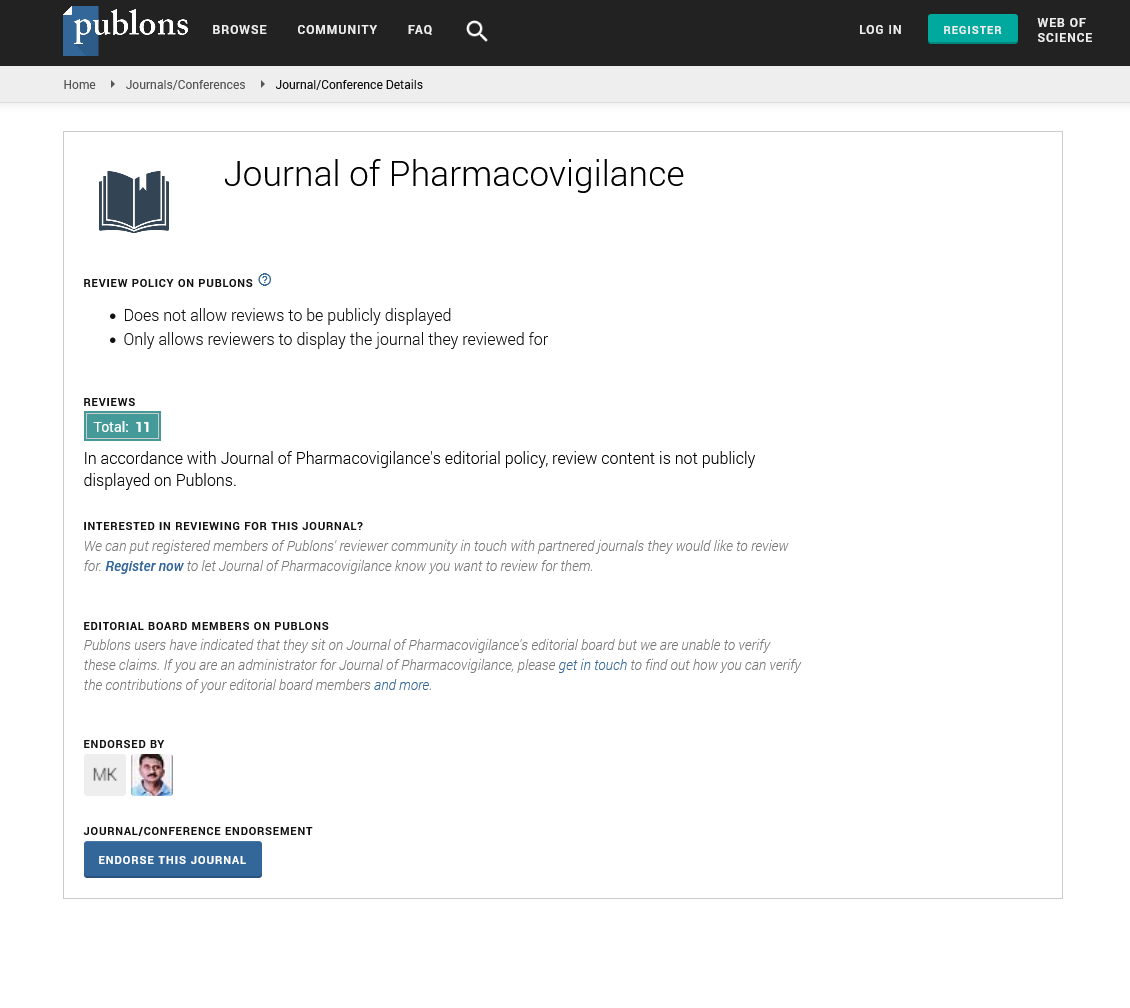Indexed In
- Open J Gate
- JournalTOCs
- The Global Impact Factor (GIF)
- RefSeek
- Hamdard University
- EBSCO A-Z
- OCLC- WorldCat
- Publons
- Euro Pub
- Google Scholar
Useful Links
Share This Page
Journal Flyer

Open Access Journals
- Agri and Aquaculture
- Biochemistry
- Bioinformatics & Systems Biology
- Business & Management
- Chemistry
- Clinical Sciences
- Engineering
- Food & Nutrition
- General Science
- Genetics & Molecular Biology
- Immunology & Microbiology
- Medical Sciences
- Neuroscience & Psychology
- Nursing & Health Care
- Pharmaceutical Sciences
Commentary - (2023) Volume 11, Issue 5
Emerging Trends in Pharmacovigilance: Harnessing Big Data and AI for Drug Safety Monitoring
Qing Pang*Received: 30-Aug-2023, Manuscript No. JP-23-23336; Editor assigned: 01-Sep-2023, Pre QC No. JP-23-23336(PQ); Reviewed: 15-Sep-2023, QC No. JP-23-23336; Revised: 22-Sep-2023, Manuscript No. JP-23-23336(R); Published: 29-Sep-2023, DOI: 10.35248/2329-6887.23.11.452
About the Study
Pharmacovigilance, the science of monitoring and evaluating the safety of pharmaceutical products, has traditionally relied on manual reporting and analysis. However, the landscape of drug safety monitoring is rapidly evolving with the integration of big data and Artificial Intelligence (AI) technologies. This article explores the emerging trends in pharmacovigilance, highlighting how the utilization of big data and AI is revolutionizing drug safety monitoring.
Historically, pharmacovigilance primarily depended on healthcare professionals, patients, and pharmaceutical companies to report Adverse Drug Reactions (ADRs). These reports were collected in databases and reviewed manually by pharmacovigilance experts. While this approach has been effective in ensuring drug safety to a certain extent, it had limitations such as underreporting, delayed identification of safety concerns, and an inability to analyze large datasets comprehensively.
Big data has transformed pharmacovigilance by providing access to vast amounts of healthcare data, including Electronic Health Records (EHRs), claims data, social media posts, and online forums. These diverse sources offer a more comprehensive and real-time view of patient experiences with medications. By applying advanced analytics to big data, pharmacovigilance experts can identify potential safety signals more quickly and accurately.
One notable example is the use of Natural Language Processing (NLP) algorithms to analyze unstructured text data from sources like social media and patient forums. These algorithms can detect ADR mentions, even when they are not reported through traditional channels. Additionally, machine learning models can prioritize and analyze large volumes of ADR reports, helping pharmacovigilance teams focus on the most critical safety concerns.
Artificial intelligence plays a crucial role in pharmacovigilance by automating various aspects of signal detection and analysis.
Machine learning models can identify patterns and associations in ADR data that would be challenging to detect manually. These models can help identify potential safety signals more quickly, leading to faster decision-making and improved patient safety.
Moreover, AI-powered predictive models can forecast potential ADRs, allowing pharmaceutical companies to proactively address safety concerns before they become widespread issues. This proactive approach can save lives and reduce healthcare costs associated with adverse events.
Another area where big data and AI are making significant contributions to pharmacovigilance is in the assessment of the risk-benefit profile of medications. By analyzing real-world data, including patient demographics, comorbidities, and concomitant medications, AI can help tailor drug safety assessments to specific patient populations.
This personalized approach to risk assessment allows healthcare providers to make more informed decisions about prescribing medications, considering individual patient characteristics and potential risks. It also enables pharmaceutical companies to optimize their drug development strategies by identifying target populations with a more favorable benefit-risk profile.
Regulatory bodies such as the U.S. Food and Drug Administration (FDA) and the European Medicines Agency (EMA) are recognizing the potential of big data and AI in pharmacovigilance. They are actively exploring ways to incorporate these technologies into their regulatory frameworks. For instance, the FDA has established the Center for Drug Evaluation and Research (CDER) Data and Analytics Center of Excellence (DaCE) to promote the use of data and analytics in drug regulation.
Conclusion
The integration of big data and AI into pharmacovigilance is entering in a new era of drug safety monitoring. These technologies offer the potential to improve the detection of adverse drug reactions, enhance risk-benefit assessments, and enable more personalized medicine. As regulatory bodies continue to adapt to these emerging trends, the pharmacovigilance landscape will continue to evolve, ultimately benefiting patients by ensuring the safety and efficacy of pharmaceutical products. It is clear that big data and AI are becoming indispensable tools in the ongoing pursuit of drug safety and public health.
Citation: Pang Q (2023) Emerging Trends in Pharmacovigilance: Harnessing Big Data and AI for Drug Safety Monitoring. J Pharmacovigil. 11:452.
Copyright: © 2023 Pang Q. This is an open-access article distributed under the terms of the Creative Commons Attribution License, which permits unrestricted use, distribution, and reproduction in any medium, provided the original author and source are credited.

